
The Daniel Hale Williams House is the former home of Dr. Daniel Hale Williams (1856-1931), one of the first major African American surgeons. Located at 445 East 42nd Street in the Grand Boulevard community area of Chicago Illinois, the building was designated a National Historic Landmark in 1975.

The Bernard Ginsburg House is a single family private residence located at 236 Adelaide Street in Midtown Detroit, Michigan, within the Brush Park district. It was listed on the National Register of Historic Places in 1991.
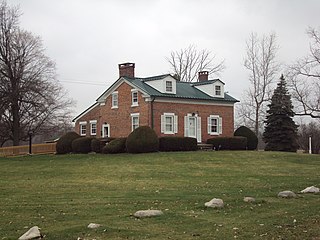
The Edward Loranger House is a private residence located at 7211 South Stoney Creek Road in Frenchtown Charter Township in Monroe County, Michigan. It was listed as a Michigan Historic Site on October 2, 1980 and added to the National Register of Historic Places on May 31, 1984. The house is significant as one of the oldest authentic structures in Michigan — having undergone very little modifications since it was first built.

The Raisin Valley Friends Meetinghouse is a historic church located at 3552 North Adrian Highway (M-52) in Adrian Charter Township about two miles (3.2 km) north of the city of Adrian in central Lenawee County, Michigan. It was added to the National Register of Historic Places on April 28, 1982 and later designated as a Michigan Historic Site on January 23, 1992. It houses the oldest Quaker congregation in Michigan, which was established in 1831. It is also recognized as the second oldest continuously operating church building in the state of Michigan after the Mission Church in Mackinac Island, which was built in 1829.

The Dr. Leonard Hall House was a private resident located at 334 West Main Street (M-34) in Hudson in westernmost Lenawee County, Michigan. It was designated as a Michigan Historic Site on April 4, 1978 and later added to the National Register of Historic Places on October 2, 1978.

The Thomas and Isabella Moore Clyde House is a private house located at 50325 Cherry Hill Road in Canton Township, Michigan. It was listed on the National Register of Historic Places in 2003.

The Marx House is a private house at 2630 Biddle Avenue in Wyandotte, Michigan. It was listed on the National Register of Historic Places and designated a Michigan State Historic Site in 1976. It is now used by the Wyandotte Historical Museum.

The Dr. George McLelland Middleton House and Garage is a historic building located in the central part of Davenport, Iowa, United States. The residence has been listed on the National Register of Historic Places since 1982.

The Fountain–Bessac House, also known as the Fountain-Haeussler House, is a private house located at 102 W. Main Street in Manchester, Michigan. It was designated a Michigan State Historic Site in 1986 and listed on the National Register of Historic Places in 1988.

The Frankfort Land Company House, also known as the John Bockoven House, is a single family house located at 428 Leelanau Street in Frankfort, Michigan, United States. It was listed on the National Register of Historic Places in 1995. It currently operates as the Stonewall Inn B & B.

The Leverett and Amanda Clapp House is a historic house located in Centreville, Michigan. The building was built in 1879–80 for Leverett and Amanda Hampson Clapp. The brick building has two stories and was built in the Italianate style.
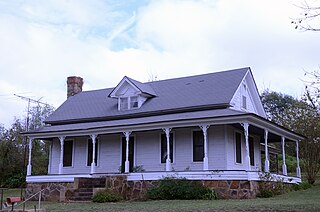
The L.D. Hutchinson House is a historic house on the east side of Arkansas Highway 31 in the small community of Floyd, Arkansas, a short way north of its junction with Arkansas Highway 305. The house is a 1 1⁄2 story wood frame structure, with a side gable roof and novelty siding. A single-story shed-roof porch extends across the west-facing front, supported by turned posts with decorative wooden bracket at the top. A single gabled dormer projects from the center of the roof, and an ell extends to the rear of the house, giving it a T shape. The house was built in 1914 by L.D. Hutchinson, a local farmer who also operated the local general store and post office.

The Dr. E.P. Hawkins Clinic, Hospital, and House comprise a historic former medical complex in Montrose, Minnesota, United States. Hawkins established his medical practice in 1897 in the front room of his residence. As his practice grew, however, he had a ten-bed hospital constructed next door in 1903, and ten years later acquired an adjacent building to use as a clinic and nursing school. The three-building complex was listed on the National Register of Historic Places in 1979 for having local significance in the theme of health/medicine. It was nominated for exemplifying Wright County's medical facilities at the turn of the 20th century.
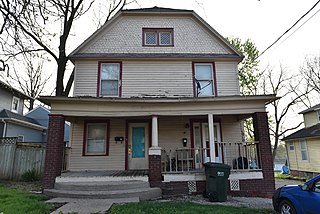
The Thomas J. Conover House is a historic residence located in Oskaloosa, Iowa, United States. Thomas J. Conover was a farmer who retired to town as a widower about 1910. He and his daughter Casa Mae Conover, lived here together while she worked at William Penn College. Between 1925 and 1951 she was a teacher of religious education, assistant registrar, secretary to the president, and the registrar. Single women who worked for the college rarely owned their own home. This suggests the difference in pay between men and women at the institution, even as it espoused gender equality. Casa had to live with her father and care for him in his old-age. Their Colonial Revival house was built about 1910. It is a two-story, frame, single-family dwelling that features a gable-end facade roof with hip-on-gable roof embellishment, fishscale shingles on the gable end, and a full-length front porch. It is the Casa Mae Conover's association with the school in the context of the Quaker testimony in Oskaloosa that makes this house historic. It was listed on the National Register of Historic Places in 1996.

The Dr. William H. and Mae R. Klose House is a historic residence located in Oskaloosa, Iowa, United States. Dr. Klose taught German at nearby William Penn College, and was one of the longer serving faculty members. His dedication to the school helped it survive through its years of turmoil. They were also among the first to settle in the Penn College Addition. The college platted and sold these lots, which in turn helped the institution financially survive. This Colonial Revival style house is a 1½-story, frame, single-family dwelling. It features a side-gable roof, a facade gambrel dormer, and a bay window to the right to the main entry. It is the Klose's association with the school in the context of the Quaker testimony in Oskaloosa that makes this house historic. It was listed on the National Register of Historic Places in 1996.

The Shafer's Grocery and Residence is a commercial and residential building located at 1018 Emmet Street in Petoskey, Michigan. It was added to the National Register of Historic Places in 1986.
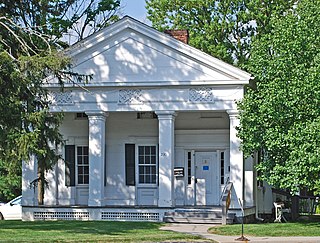
The William Anderson House is a single-family home located at 2301 Packard Road in Ann Arbor, Michigan. It was listed on the National Register of Historic Places in 1983.

The Bell-Spalding House, also known as the Tuomy House, is a single-family home located at 2117 Washtenaw Avenue in Ann Arbor, Michigan. It was listed on the National Register of Historic Places in 1990.

The Floyd R. Mechem House is a single-family home located at 1402 Hill Street in Ann Arbor, Michigan. It was listed on the National Register of Historic Places in 1999.
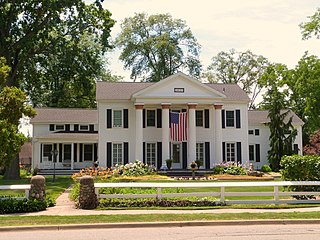
The Abel Brockway House is a single family home located at 1631 Brockway Street in Saginaw, Michigan. It was listed on the National Register of Historic Places in 1982.


























